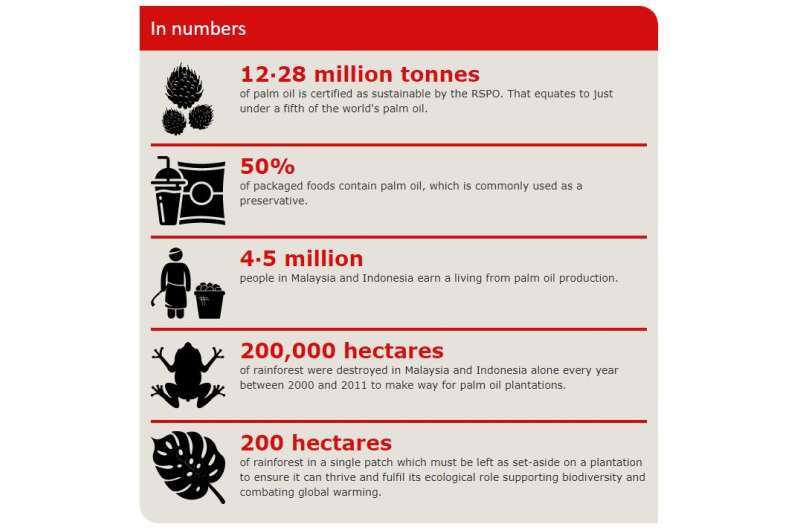Protecting biodiversity in palm oil

News that chocolate, bread and dried fruit all share a common ingredient with household detergents and cosmetics might sound both unlikely and unappetising.
However, palm oil is used in each of these and many more everyday products. It is the world's primary source of vegetable oil, and also a common biofuel, driving up global demand further.
Oil palms are native to Africa, but around 85% are grown in South East Asia. It is their abundant golf-ball-sized orange fruits which are used to make palm oil. The expanding market has triggered an explosion of commercial plantations across South East Asia and into new 'frontiers' in Africa and Central and South America, destroying vital rainforest along the way.
As a result, there is a widening effort to grow palm oil sustainably, so it can provide a viable income for growers without losing valuable rainforest and the ecological benefits it brings, from providing habitat to combating global warming.
Strengthening sustainability
Eagle-eyed shoppers will have spotted 'sustainable palm oil' appearing in the ingredients listed on products such as oatcakes. But conservationists have questioned whether the industry standard is actually sustainable. Previously, under the voluntary certification system, growers could label their palm oil as sustainable if they didn't plant on untouched rainforest. They could plant on some degraded rainforest, as long as areas of high conservation value are set aside and protected. However, research has shown that even very degraded rainforest can be vital for biodiversity and carbon storage.
How much is enough?
The industry response has been patchy, with differently sized areas of forest set aside on plantations and no proof that they allow the forest to perform key ecological functions.
These concerns inspired Oxford University ecologist Jennifer Lucey to conduct pioneering research, funded by NERC, to calculate the minimum size needed for a conservation set-aside on a plantation to effectively support biodiversity.
She found that each patch must have a core area of at least 200 hectares of rainforest. Smaller areas did not support significantly more species than the plantation crop itself, and dominant tree species were unable to regenerate successfully.
Jennifer's work has been used to develop a 'no-deforestation' toolkit called the High Carbon Stock (HCS) Approach. This methodology is now being applied across millions of hectares in the tropics, saving important fragmented and degraded forest from being cut down to make way for oil palms and other crops. Big firms, including Unilever, have committed to this approach as consumers become more aware of the need for sustainable palm oil.
The Roundtable on Sustainable Palm Oil (RSPO), a group including growers and conservation charities which runs the certification scheme, is now incorporating Jennifer's methodology into its own principles and criteria.
Jennifer says: "It's the deforestation issue which is the overriding factor, the one non-governmental organisations are campaigning for, and that my work has focused on. The sustainability standard is a process of continuing improvement. There has been a knowledge gap for some time on how big set-aside needs to be to support biodiversity. Until now, growers have been told bigger is better and no-one was willing to put a number on it, which meant it was left up to companies to decide how much to give up."
Simplifying certification
Around 3·57 million hectares of palm oil are currently RSPO certified, but that is only about a fifth of the market. While consumers across Europe, America and Australasia increasingly demand sustainable products, they are less popular for many others in China, India and Africa, which gives growers less incentive to seek a sustainability certification.
Another issue is that roughly 40% of palm oil is grown by smallholders who often find the process of obtaining RSPO certification too expensive and complicated.
In a bid to persuade smaller producers to grow palm oil sustainably, Jennifer also worked with the RSPO to create maps highlighting the likely locations of the most valuable conservation areas. The RSPO is about to incorporate the maps into its assessment procedure for smallholders, for whom the current costs of certification can be greater than the benefits.
"This will allow the many smallholders operating in low-risk areas far from forests and peatland to become certified through a simplified process, hopefully increasing uptake," she says.
Switching is not the answer
With more than 60 million tonnes of palm oil produced worldwide—of which just under a fifth is certified as sustainable—consumers question why it is used in so many products. One of the most common uses of palm oil is as a preservative to extend the shelf-life of various foods, leading some to ask whether substituting it for another oil would help.
Jennifer says: "Oil palms produce at least six times more oil per hectare than the next most productive crops, such as rapeseed or soy, so switching is not a more sustainable option."
Looking ahead, the RSPO and non-governmental organisations are working to improve sustainable palm oil further, with some studies suggesting that there is enough brown field land for plantations to meet current demand for palm oil.
"It's about putting it in the right place," Jennifer says.
Provided by PlanetEarth Online
This story is republished courtesy of Planet Earth online, a free, companion website to the award-winning magazine Planet Earth published and funded by the Natural Environment Research Council (NERC).





















